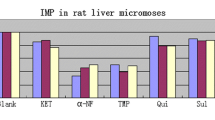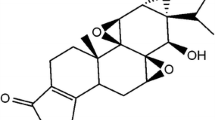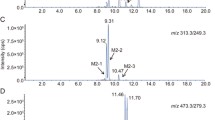Abstract
Chloroquine has been used for many decades in the prophylaxis and treatment of malaria. It is metabolized in humans through theN-dealkylation pathway, to desethylchloroquine (DCQ) and bisdesethylchloroquine (BDCQ), by cytochrome P450 (CYP). However, until recently, no data are available on the metabolic pathway of chloroquine. Therefore, the metabolic pathway of chloroquine was evaluated using human liver microsomes and cDNA-expressed CYPs. Chloroquine is mainly metabolized to DCQ, and its Eadie-Hofstee plots were biphasic, indicating the involvement of multiple enzymes, with apparent Km and Vmax values of 0.21 mM and 1.02 nmol/min/mg protein 3.43 mM and 10.47 nmol/min/mg protein for high and low affinity components, respectively. Of the cDNA-expressing CYPs examined, CYP1A2, 2C8, 2C19, 2D6 and 3A4/5 exhibited significant DCQ formation. A study using chemical inhibitors showed only quercetin (a CYP2C8 inhibitor) and ketoconazole (a CYP3A4/5 inhibitor) inhibited the DCQ formation. In addition, the DCQ formation significantly correlated with the CYP3A4/5-catalyzed midazolam 1-hydroxylation (r=0.868) and CYP2C8-catalyzed paclitaxel 6α-hydroxylation (r = 0.900). In conclusion, the results of the present study demonstrated that CYP2C8 and CYP3A4/5 are the major enzymes responsible for the chloroquineN-deethylation to DCQ in human liver microsomes.
Similar content being viewed by others
References
Ademowo, O. G., Sodeinde, O., and Walker, O., The disposition of chloroquine and its main metabolite desethylchloroquine in volunteers with and without chloroquine-induced pruritus: evidence for decreased chloroquine metabolism in volunteers with pruritus.Clin. Pharmacol. Ther., 67 (3), 237–241 (2000).
Augustijns, P., Geusens, P., and Verbeke, N., Chloroquine levels in blood during chronic treatment of patients with rheumatoid arthritis.Eur. J. Clin. Pharmacol., 42 (4), 429–433 (1992).
Bourrie, M., Meunier, V., Berger, Y., and Fabre, G., Cytochrome P450 isoform inhibitors as a tool for the investigation of metabolic reactions catalyzed by human liver microsomes.J. Pharmacol. Exp. Ther. 277 (1), 321–332 (1996).
Broly, R., Libersa, C., Lhermitte, M., Bechtel, P., and Dupuis, B., Effect of quinidine on the dextromethorpha.O-demethylase activity of microsomal fractions from human liver.Br. J. Clin. Pharmacol., 28, 29–36 (1989).
Ducharme, J. and Farinotti, R., Rapid and simple method to determine chloroquine and its desethylated metabolites in human microsomes by high-performance liquid chromatography with fluorescence detection.J. Chromatogr. B Biomed. Sci. Appl., 698 (1-2), 243–250 (1997).
Eagling, V. A., Tjia, J. R., and Back, D. J., Differential selectivity of cytochrome P450 inhibitors against probe substrates in human and rat liver microsomes.Br. J. Clin. Pharmacol., 45 (2), 107–114 (1998).
Ette, E. I., Brown-Awala, E. A., and Essien, E. E., Chloroquine elimination in humans: effect of low-dose cimetidine.J. Clin. Pharmacol., 27 (10), 813–816 (1987).
Ette, E. I., Essien, E. E., Thomas, W.O., and Brown-Awala, E.A., Pharmacokinetics of chloroquine and some of its metabolites in healthy volunteers: a single dose study.J. Clin. Pharmacol., 29 (5), 457–462 (1989).
Frisk-Holmberg, M., Bergqvist, Y., Termond, E., and Domeij-Nyberg, B., The single dose kinetics of chloroquine and its major metabolite desethylchloroquine in healthy subjects.Eur. J. Clin. Pharmacol., 26 (4), 521–530 (1984).
Gustafsson, L. L., Walker, O., Alvan, G., Beermann, B., Estevez, F., Gleisner, L., Lindstrom, B., and Sjoqvist, R., Disposition of chloroquine in man after single intravenous and oral doses.Br. J. Clin. Pharmacol., 15 (4), 471–479 (1983).
Harris, J. W., Rahman, A., Kim, B. R., Guengerich, F. P., and Collins, J. M., Metabolism of taxol by human hepatic microsomes and liver slices: participation of cytochrome P450 3A4 and an unknown P450 enzyme.Cancer Res., 54, 4026–4035 (1994).
Ofori-Adjei D. and Ericsson, O., Chloroquine in nail clippings.Lancet, 2 (8450), 331 (1985).
Onyeji, C. O. and Ogunbona, F A., Pharmacokinetic aspects of chloroquine-induced pruritus: influence of dose and evidence for varied extent of metabolism of the drug.Eur. J. Pharm. Sci., 13 (2), 195–201 (2001).
Onyeji, C. O., Toriola, T. A., and Ogunbona, F A., Lack of pharmacokinetic interaction between chloroquine and imipramine.Ther. Drug Monit., 15 (1), 43–46 (1993).
Shimada, T., Yamazaki, H., Mimura, M., Inui, Y., and Guengerich, F. P., Interindividual variations in human liver cytochrome P-450 enzymes involved in the oxidation of drugs, carcinogens and toxic chemicals: studies with liver microsomes of 30 Japanese and 30 Caucasians.J. Pharmacol. Exp. Ther., 270 (1), 414–423 (1994).
Tassaneeyakul W., Birkett D. J., Veronese M. E., McManus M. E., Tukey R. H., Quattrochi L. C., Gelboin H. V., and Miners J. O. Specificity of substrate and inhibitor probes for human cytochromes P450 1A1 and 1A2.J. Pharmacol. Exp. Ther., 265, 401–407 (1993).
Thummel, K. E., Shen, D. D., Podoll, T. D., Kunze, K. L., Trager, W. F., Hartwell, P. S., Raisys, V. A., Marsh, C. L., McVicar, J. P., Barr, D. M., Perkins, J. D., and Cariers, R. L., Use of midazolam as a human cytochrome P450 3A probe: I. In vitro-in vivo correlations in liver transplant patients.J. Pharmacol. Exp. Ther., 271, 549–556 (1994).
Wrighton, S. A., Stevens, J. C., Becker, G. W., and Vandenbranden, M., Isolation and characterization of human cytochrome P4502C19: Correlation between 2C19 and S-mephenytoin 4’-hydroxylation.Arch. Biochem. Biophys., 306, 240–245 (1993).
Author information
Authors and Affiliations
Corresponding author
Rights and permissions
About this article
Cite this article
Kim, KA., Park, JY., Lee, JS. et al. Cytochrome P450 2C8 and CYP3A4/5 are involved in chloroquine metabolism in human liver microsomes. Arch Pharm Res 26, 631–637 (2003). https://doi.org/10.1007/BF02976712
Received:
Issue Date:
DOI: https://doi.org/10.1007/BF02976712




